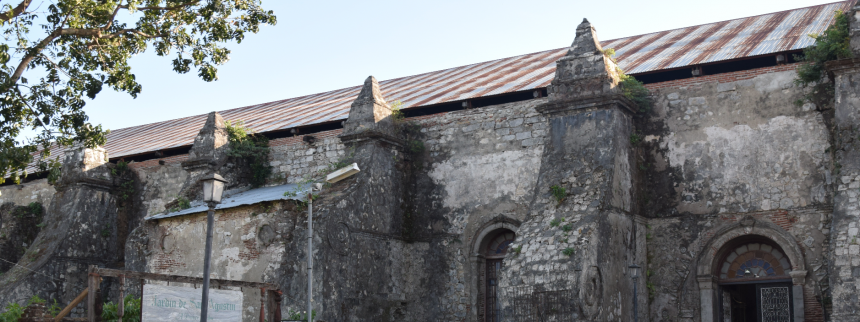
Earthquake Baroque. This was how the tour guide described the architectural style of the Paoay Church of St. Augustine and other colonial churches in the Ilocos region, “Earthquake Baroque”.
Like the missions in California, the construction of churches in this region of the Philippines was plagued by volcanic moods and tectonic tremblings. The style known as “Earthquake Baroque” was the wisdom gleaned from much frustrating trial and error.
The Church of St. Augustine bears many of the common features of colonial churches, the principal facade is a complex array of patterns intended to invite contemplation. It suggests an epiphany wondrously emerging from a clouded mystery. In the folds and curves emerge both angels and saints. All of this is the prelude to what awaits one inside God’s temple.
Thick buttresses were common for Baroque churches. For one, this was needed to support the heavy roof. The colonial Filipino churches did not have this demand because the roofs were thatched with the local grass. Their buttresses, though, had great girth as a precaution against tremors. The buildings appeared weighty and solid.
At my first look I was curious about an exterior staircase that seemed to lead directly to the stone wall, no nearby door or window to be found. The guide explained its practical function: easy access to the roof in order to tend or replace the grass thatch.
Now, the roof is made of corrugated tin sheeting set upon a soldered frame resting on the walls of the Church. The tin roof is an unbecoming contrast to the aging Baroque elegance of the rest of the church. The risk of fires and the current inaccessibility of the once abundant grass means the roof is a necessary make-do.
Other colonial churches have made other like-wise adaptations to the roof for the same reasons with only minor improvement to the architectural dissonance. Many have these grand stone stairs that beautifully serve a vital function but now simply suggest a stairway to heaven.
Another learning from the earthquake school of hard-knocks: most of the bell towers are constructed apart from their churches as a precautionary measure.
The interiors of the Church reflected the accumulation of time and history. Statues of Christ, the Blessed Mother, and various saints are stoic sentinels looking over the sacred nave, some from their alcoved niches, some from glass enclosures on side altars, others resting in a unobtrusive corner from any number of religious processions requiring their honorary companionship.
Many of the array of statues were crafted for devotional and catechetical purposes. These ancient images shared the nave with arrays of video monitors, speakers, and the accompanying wires amplifying the Mass, posting the responses of the people and scrolling the lyrics of the hymns.
A lively clutter signals the vibrant religiosity of the Filipino people. At no time in the Paoay Church or any other church was the nave without worshippers lingering after Mass, waiting for the next, or just keeping company with the Lord.
---
Click here for a Facebook photo album that follows Bishop Soto's journey in the Philippines.
Did you miss a dispatch? Find them all here: First | Second | Third | Fourth | Fifth | Sixth | Seventh

